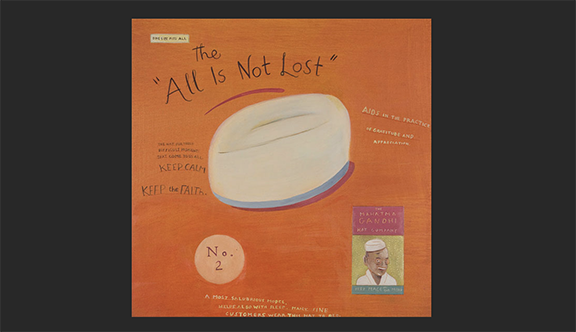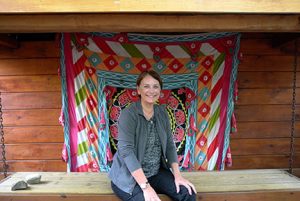 Cat Bennett is an artist and writer who believes that everyone can draw and use the practice of drawing to grow awareness of the creative self within. Her experience in Yoga class helped her to understand the relationship between art and spiritual practice. In this article, she explains how drawing offers us a chance to be fully present and explore visual expression; to find our true creative selves again so we can bring our creativity into our lives and into the world. (photo: painting from the series “The Mahatma Gandhi Hat Company by Cat Bennett)
Cat Bennett is an artist and writer who believes that everyone can draw and use the practice of drawing to grow awareness of the creative self within. Her experience in Yoga class helped her to understand the relationship between art and spiritual practice. In this article, she explains how drawing offers us a chance to be fully present and explore visual expression; to find our true creative selves again so we can bring our creativity into our lives and into the world. (photo: painting from the series “The Mahatma Gandhi Hat Company by Cat Bennett)
In Yoga class some years ago, I had one of those “Aha!” moments. I saw that art too can be practiced in a yogic way, making it a powerful spiritual practice available to each of us and one that can lead us into the creative flow with ease.
In one of my first Yoga classes, my teacher, Laura Sevika Douglass [an Integral Yoga teacher and associate editor of this magazine], asked us to notice our thoughts as a way of knowing ourselves more fully, potentially altering our approach to life. In the midst of ardha chandrasana, half-moon pose, one leg in the air and the other wobbling, I began to think, “This is hard, and boring.” I would have given up were it not for appearing wimpish. Then Laura gently asked us to watch our thoughts. She suggested our mental attitude to every challenge in life might be the same as our attitude to the challenge of half-moon pose in this moment. I was forced to notice my desire to look good, my impatience and the thoughts of giving up when things are hard! Then Laura asked us to notice the Self who was observing all our mental gymnastics and to try to be in that Self.
Later, in a class on Patanjali’s Yoga Sutras, Laura said that asana practice also gives us the opportunity to develop one-pointed focus and concentration. She described how this focus allows us to be totally at one with the moment, free of mind chatter, self-flattery and even crankiness. All the shopping lists, worries, gripes and mental conversations—vamoose! In other words, we can slip out of our egotistical, small selves and into our true, loving, peaceful core of awareness. And what a beautiful place that is to be! It’s also the place where true creativity resides, where inspiration comes to meet us. As she spoke, I realized that this happens not just in asana practice, but in making art as well. The “Aha!” for me was that art can be a practice to help lead us to connection with Spirit, if approached in the same way.
I’ve been an artist all my life. For 40 years now I’ve drawn many hours a day, many days a week—from when I was a highly-strung, fun, dreamy, occasionally alienated, frequently overly social, confused teenager until now. Sometimes, it was hard to sit down or to sit still, but gradually, gradually, I sat there longer and longer as I struggled to master skills, find out who I was and discover what art could do. Drawing called to me and, really, it was Spirit calling. More and more, I slipped into the place of one-pointed focus and peace. I enjoyed that space yet, curiously, never thought about it. I had no real understanding of what was happening but I learned how to focus on the drawing in front of me with total presence. Drawing allowed me to forget everything and just be. I came to look forward to sitting down to draw. My “Aha!” moment in Yoga class showed me that we can also draw and make art to encounter and grow the peace within.
Despite common belief, everyone can draw, as all children do. Drawing is seldom taught in our public schools, so it’s no wonder many of us give it up. As adults, some of us long to play with art again, as if some vital, imaginative, non-verbal part of ourselves has been lost. When we begin, we often feel an enormous sense of relief. Art connects us with our true creative selves—open, fresh, playful and brave.
What happens when we draw is that we move automatically, and quite quickly, from our analytical, verbal left brain into our spatial, imaginative and meditative right brain. We’ll begin to recognize this shift in time. It’s the place where time disappears and words go unheard. This happens for us even if we’re just doodling but all forms of drawing will lead us into stillness because of the focus it requires.
Often we think of art in terms of what we make. We often judge it as “good” or “bad,” and now, in this way of drawing, we can let such thoughts go. As we enter our peaceful core, Spirit and inspiration come to meet us. When we act on inspiration immediately, without hesitation, we enter the true creative flow. The more we do the more we see—who we are, where we’ve been, what we might offer. We create what we could never figure out using our limited minds.
A drawing practice means we show up regularly—to draw freely and find presence. When we begin each session, we can think about our attitude. Many adults are anxious about drawing, though children seldom are. Adults need to forget inhibitions. Drawing is not about being good or rendering with accuracy. It’s about showing up, going where we’ve never been before and seeing what emerges—our sweet hand on the page. We’ll grow skills in time alongside the ability to sit still, to allow what is happening, to observe our minds and rest in the peace deep within.
The path of the artist is winding and occasionally precipitous. By artist, I mean each of us who engages in creative practice. There are obstacles, but these are mostly in our minds. We might think: “This is too hard!” or “I don’t have any talent!” or “No one will buy my work!” When we notice such thoughts, we can learn to let them go, toss our paper in the air and begin again. That’s the practice of all artists. We can learn to change our negative thoughts to positive ones—to say it’s easy, that every hand is unique and that our work is a gift to others. We may compare our fledgling efforts to those of a mature Matisse and sink into despair. It happens. We have a choice—to give up or carry on. Faith is always a choice. Part of our practice is to choose it over and over again, to trust we are growing our connection to our true creative selves. Our practice is to work with our minds and go beyond them.
Drawing is training for life. Our drawing practice will encourage us to live from our creative core. Whatever freedom, faith and bold exploration we cultivate on the page, we can bring into the whole of our lives, like we do with Yoga.
A few years ago, I began to teach drawing to adults. I was surprised, at first, at how many of my students were anxious. In an early class, my student, Mari, burst into tears. “I’m scared,” she said. So we began just by making marks like small children. I was sure that would dispel any concerns, but it didn’t. Another student asked, “But how do we know we’re doing it right?”
Then Mari told us a story. She confessed she’d come from a family of modest means. When she was ten she’d had a teacher she adored who dressed beautifully. Mari’s mother saved up and bought her a beautiful yellow dress, which she couldn’t wait to wear to school. When she was handing in her homework, her teacher gently pulled her aside and said, “You should never wear yellow. It’s not a good color on you.” All these years later, the hurt still lingered and Mari worried about getting it right.
Mari’s total presence to her feelings and her courage to share them set us on a course of simply drawing to find presence and total acceptance for who we are and where we are. We had only one rule—to find something wonderful in each other’s work to appreciate, even our doodles. Every hand is unique so it’s not difficult to do. For a whole year, Mari’s lines were wavy and agitated. I thought they were her style and loved them. Later, she confessed she was so nervous her hand was shaking. In time, her lines became more assured and steady. She went on to be very inventive with her drawings—stitching them on fabric. She has since shown her work in a gallery and now loves exploring art.
In the beginning of my own art journey, I enjoyed the peace drawing afforded. Perhaps that’s why I stuck with it. What surprises me, however, is that I wasn’t aware of this peace and able to bring it into more of my life. Drawing was a refuge. In my younger life, my mind was as scattered as fallen leaves in autumn—here, there and everywhere. This yielded the inevitable results of a here, there and everywhere life full of small and, occasionally, large dramas. Yet, clumsily, ineptly, sitting down each day to draw, I was at peace and, in that place, began to feel the deep longing to connect with spirit, with all that I felt was good in life, and to be my true self. That longing eventually brought me to Yoga.
There is more to spiritual practice, I know. It goes beyond making art, or standing in half moon pose, to living each moment in a state of awareness. Few of us always succeed. I certainly don’t, but now I can see when I veer off course. Yoga opened my eyes and art gives me a way to practice being here fully and to connect with my true creative Self.
About the Author:
 Cat Bennett’s illustrations have appeared in many newspapers and magazines including The Boston Globe, The New York Times, The Atlantic Monthly, The Baltimore Sun and Time magazine. She has made short animations for Sesame Street, Nickelodeon TV and various non-profits. Her art has been exhibited in Boston, New York, Montreal and Tokyo. Her book, The Confident Creative/Drawing to Free the Hand and Mind, was named a gold medal winner in the 2011 Nautilus Book Awards. Her articles have appeared in The Huffington Post, The American, Yoga Magazine, Red and many other publications. For more information on Cat Bennett and her work go to: catbennett.net.
Cat Bennett’s illustrations have appeared in many newspapers and magazines including The Boston Globe, The New York Times, The Atlantic Monthly, The Baltimore Sun and Time magazine. She has made short animations for Sesame Street, Nickelodeon TV and various non-profits. Her art has been exhibited in Boston, New York, Montreal and Tokyo. Her book, The Confident Creative/Drawing to Free the Hand and Mind, was named a gold medal winner in the 2011 Nautilus Book Awards. Her articles have appeared in The Huffington Post, The American, Yoga Magazine, Red and many other publications. For more information on Cat Bennett and her work go to: catbennett.net.

